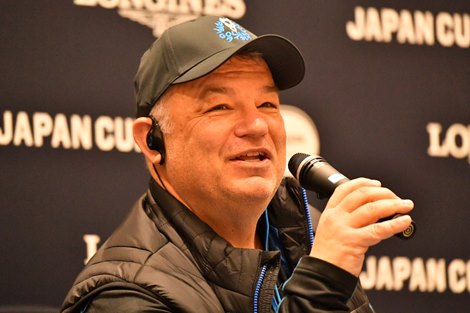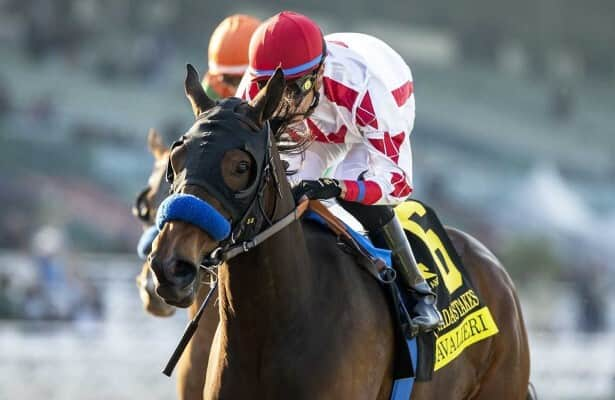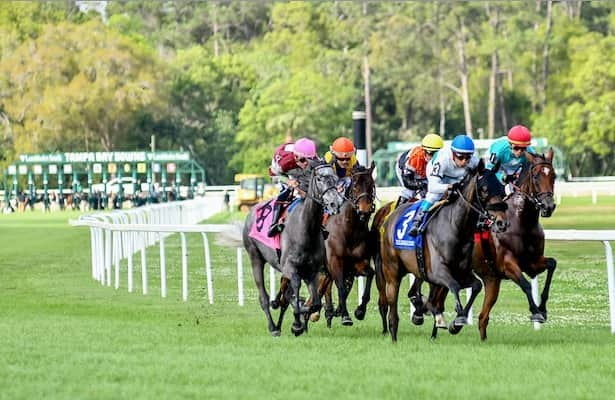As I reflect on my first year as a newcomer in the horse racing industry, I wish to take a moment to express my heartfelt gratitude to all those who have welcomed me into this sport. Stepping into something unfamiliar can be daunting, especially with the significant investment I have made. The accomplishments I have achieved this year are a direct result of the support and encouragement I have received from many individuals who have helped me establish my operations.
I believe it is also important to share my perspective on some of the positive developments occurring within our industry.
First and foremost, I extend warm wishes for a Happy Thanksgiving.
This year, I am especially thankful for my team at @ResRacingKY. It is astonishing to think that just a year ago, we had no farm and only a handful of horses. Our farm staff has risen to the challenge of supporting the rapid growth of our operations, which now includes more than 200 Thoroughbreds in breeding, training, and active racing. Their dedication has been remarkable, and I am particularly grateful for the contributions of Noel Murphy and Gavin O’Conner. Alongside our Thoroughbred activities, Chelsey Stone manages a Saddlebred breeding operation, an active rescue program, and my personal favorite, the trail horses that I taught myself to ride.
I take great pride in my daughter Sarah, who shares our passion for animals. Her leadership in our marketing and branding initiatives, as well as her commitment to our rescue efforts for retired racehorses, has been exemplary.
I would also like to highlight several significant achievements within the industry over the past year while recognizing that there is still much work to be done to reach our ideal goals. I hope these reflections inspire others to take bold actions to enhance our sport and acknowledge the dedication of many individuals who have devoted their lives to its advancement.
This year has marked a pivotal moment for California racing, largely thanks to the support from the @1st_racing in launching the California Crown. This initiative has been a tremendous success, demonstrating the remarkable outcomes we can achieve when we collaborate as an industry. Belinda (Stronach), Aidan (Butler), and their entire team truly care about horse racing and have invested millions to enhance the fan experience. I witnessed this firsthand at the Pegasus event in January and the Preakness. As a new participant, I have actively sought feedback from members to explore potential improvements. While challenges remain, their commitment to our industry and the significant resources they have devoted to keep racing alive in California deserve commendation. Through constructive dialogue, I am confident they seek further enhancements, though they do not have unilateral control over all decisions.
Although the introduction of @HISA_US has encountered obstacles, we have observed a decline in on-track fatalities, and the industry’s adaptation to more structured standards is becoming clearer. I acknowledge that improvements are necessary, which is why I have volunteered to serve on HISA’s advisory board. I want them to succeed, as they are the most influential body in the U.S. racing landscape.
Successful owners continue to invest in the industry, often without seeking recognition or self-promotion on social media. The media has played a crucial role in promoting the sport and addressing complex issues, including aftercare for horses and the implementation of HISA. Jayson Werth, after a successful career in baseball, has experienced the unique fulfillment of competing on the track. Through individuals like Jayson, we have an opportunity to share this narrative with many potential owners, attracting further investment. Additionally, Travis Kelce’s entry into horse ownership could have a transformative effect on the sport, similar to what he has done for the NFL.
This year, horseplayers have enjoyed greater access to sports betting, thanks to initiatives from @FanDuel and @DraftKings, which have promoted deregulation in this area. While there is still room for improvement, these developments have positively impacted the game. We can also draw valuable lessons from successful models in Australia and Japan regarding the management of gambling revenue, enabling horseplayers to expand their operations and increase profitability.
Organizations such as @JockeyClub, @ChurchillDowns, @Keeneland, and @TheNYRA have played a vital role in collaborating with HISA to enhance the safety of our equine athletes. As new leadership emerges, we should rally behind them and amplify our collective voice to effect positive change.
Significant investments have also been made in the infrastructure of historic tracks such as Churchill Downs, Keeneland, and Belmont Park, creating venues that will captivate the next generation of horse racing fans. This investment is crucial and must extend to improving backstretch conditions to eliminate contamination issues and enhance living standards for both our equine athletes and the dedicated workers who support them. Protecting our collective investment means owners will need to accept increased boarding rates to fund these improvements.
We are witnessing new owners making substantial investments in bloodstock, racing, and, most importantly, fan engagement. This is essential for our long-term success. The current fan experience lacks transparency, and owners, jockeys, and trainers need to be more accessible to their fan base. Engaging with fans will create more opportunities for interaction and transparency. Some premium events have become prohibitively expensive for everyday fans, and we must create accommodations to make these events more accessible for families, such as picnic areas in the infield and dedicated seating.
I am particularly grateful to Drew Fleming and the team at @BreedersCup for helping us host our inaugural Resolute fan event.
Stallion farms are taking bold risks by acquiring horses such as Justify , Complexity , McKinzie , and others. These investments are yielding exceptional track performers from first-time sires, exciting racing fans, and providing returns for owners and breeders committed to producing top-quality horses. This business is vital, and we must trust these farms, which are the backbone of our industry, to effectively manage their stallion operations. A disciplined approach to breeding top mares with proven bloodlines is essential; however, introducing stallions with alternative bloodlines can diversify the gene pool, making it possible for a broader range of buyers to participate in breeding operations and racing programs. I believe private stallions can also offer solutions for smaller breeders, similar to models from the early 20th century.
Moreover, deregulation has enabled racing syndicates such as @MyRacehorse to make horse ownership accessible to a new demographic that once found it unattainable. We need to work with regulators to establish guidelines for horse ownership, as horses should not be classified as securities. The current regulatory oversight stifles investment. Microshare ownership can significantly broaden the fan experience in a meaningful way.
Groups like @LightUpRacing are facilitating discussions about the positive developments within the industry. While there are always areas for improvement, people respond better to positive reinforcement than to unchecked complaints. Given the pervasive grievances in our society, it would be refreshing for horse racing to serve as a unifying force, positioning the industry for the next century.
Having worked in business for over 30 years, I have observed that those who complain often lack the drive to implement genuine improvements. The real changemakers are the individuals dedicated to enhancing our industry. I have had the privilege of meeting many dedicated professionals in global equine operations, and it is clear that the industry is filled with individuals who love and care deeply for these animals.
Global sales have reached unprecedented heights, increasing value for owners and breeders, thanks to organizations committed to promoting well-bred horses and owners willing to invest in top-quality stock. This economic model has persisted for thousands of years; consumer demand shapes the direction of products, and if consumers were dissatisfied, prices would not be rising.
While challenges remain, particularly regarding Thoroughbred aftercare, I firmly believe that collaboration can ensure long-term care for all our equine athletes. We must address the situation in Louisiana, where Thoroughbreds are traded as livestock with little regulation, necessitating accountability. I am confident that with collective efforts, this issue can be resolved.
Additionally, I believe we need to collaborate with racing officials to reassess the distribution of purses for allowance and stakes races. While prize money in the U.S. is among the highest globally, the current distribution primarily benefits the winning horse. The significant disparity between first and second place makes it challenging to sustain a profitable racing operation. I propose a more equitable prize pool distribution, where the top share is divided among participants in stakes races to cover at least six weeks of training costs for each horse. This should include incentive funding from states, with the remaining prize money cascading down to lower-placed horses, ensuring the winner receives no more than 50% of the pool. This approach would provide immediate relief to mid-level owners who urgently need cash flow to continue investing in their operations, particularly those without extensive breeding operations to offset racing costs.
I agree on the necessity for leadership within our sport. We need leaders of integrity who are not merely in the industry for self-promotion or to belittle others who have dedicated their lives to a sport we all cherish. Such divisive behavior is counterproductive, especially when we need to unite.
I encourage everyone to share their thoughts and opinions and foster respectful dialogue. I do not condone disrespectful behavior and will remove individuals from my feed if they cannot engage civilly.
I wish each of you a wonderful Thanksgiving. Despite the challenges our industry and country face, I remain optimistic. I believe our great nation grants us the freedoms and opportunities that many have sacrificed their lives for, and it is our duty to honor their legacy through dedication and hard work.
I am reminded of JFK’s vision of landing on the moon within a decade: “We choose to go to the moon not because it is easy, but because it is hard. This goal will serve to organize and measure the best of our energies and skills, because this challenge is one we are willing to accept, one we are unwilling to postpone, and one which we intend to win.”
I recognize that there are many issues I have not addressed in this message. I know many of you are dedicated to creating change and caring for our equine athletes. I challenge each of us to prioritize the collective industry over individual interests, understanding that our success depends on contributions from everyone. It is easy to be self-centered; the hard path is to work collaboratively. Haven’t we had enough of the former?
It is not working, so why not try a different approach that encourages collaboration and support? I have no pride of authorship and will endorse any initiative that propels our industry forward.
I also want to announce that I will personally fund a comprehensive review of the industry, examining various issues and identifying potential solutions. We can learn from industries that have successfully navigated even more significant challenges than ours. By studying their transformations, we can find methods to benefit the entire industry.
For example, the NFL has transformed into one of the most successful sporting operations globally, despite facing lawsuits over concussions and increased scrutiny regarding players’ mental health. Similarly, Formula 1, after being in decline a decade ago, has experienced rapid growth and revitalization under new ownership, enhancing both fan engagement and driver safety.
I invite all industry participants to support this review, and I pledge to share the findings for the benefit of the entire community.
I entered this industry not to win races, not to become a leader or disruptor, but because I love horse racing. I cherish the horses and enjoy spending time with individuals who share my belief in the importance of horse racing for our economy, particularly in the great state of Kentucky. While I am competitive and desire to win races, I measure my success by the positive impact we have on the horses and the industry as a whole.
Some may doubt my sincerity, but I challenge you to get to know me and judge me by my actions rather than my words.
May God bless you and your families this holiday season.
Once again, I wish you all a Happy Thanksgiving.












